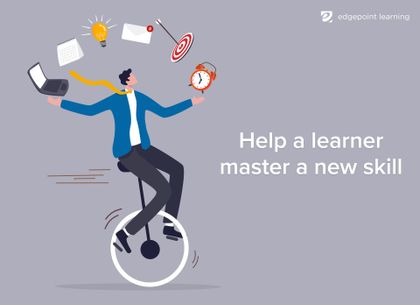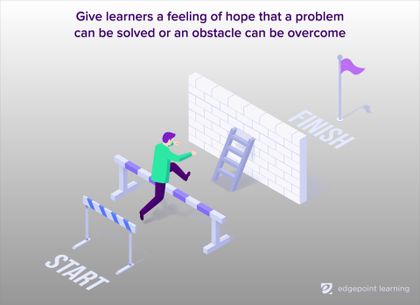Scenarios: A Key to Better Compliance Training
🍿 6 min. read
Let's face it: employees don't just want training—they want training with a purpose. They want to know that what they're learning will impact their job, improve their performance, or help them grow personally or professionally. And when it comes to compliance training, they want to know the material will help them stay on the right side of law and policy and avoid costly mistakes. Using scenarios in your training can help meet these goals.
The power of storytelling
Employees need to engage with their training. A great way to help ensure a more engaging—and fulfilling—learning experience is through scenarios that put learners into real-world, realistic situations to help them make decisions in a relevant context.
Marketers have known for years the importance of storytelling in helping customers connect with a brand and make purchasing decisions. Put bluntly, people make decisions not based on logic alone but also emotion. This research is relevant to more than just marketing activities. It gives us some insight into how people make decisions.
When you tell a good story, people are more likely to want to know more, including how the information can help them do better in a job or in life. Let's learn more about scenarios and how they can help you increase workforce training engagement.
Scenarios help train for the real world
Sure, you can deploy training—including compliance training—that simply states facts and checks boxes. There's no law against it! But will your employees really remember anything from an experience like that? Pages of unemotional text can get repetitive, and there's a risk learners will get bored and lose their motivation to stay with the training other than to “just get it done.”
Consider this: With the rise of social media platforms that encourage quick, entertaining videos and short, silly memes, adult learners have come to expect more than just words on a screen. To hold attention, you need to offer people a reason to stay tuned in and content they can relate to. Otherwise, there's a real possibility they'll just tune out.
What if you could spice up the training stew with a dash of relevance, a pinch of emotion, and a smidgen of story? What if you could immerse your employees in real-world situations with real stakes and consequences? That can make your training stickier, more memorable, and even something to talk about around the water cooler (or in a virtual chat).
It's what scenarios are all about, and they can elevate training—and hold learner attention and interest—in a way few other devices can.
Keys to better scenarios
Think of scenarios like a story running through your training—a story you can change to suit different departments and targeted skills, a story that is flexible enough for complex challenges and decisions or simple tasks.
Like any story, scenarios should be planned and structured to maximize their impact. Let's review a few good guidelines to help your scenario stories sizzle.

1. Know the ending.
Think of your favorite book or movie. It probably has a character who uses a skill they discovered to reach a goal. Maybe the superhero learned to use their powers to protect a city or the wizard uses their magic to save the world. The point is, there was something that had to be done, and all the action—and learning— was aimed at that goal. Scenarios are no different. They should teach something relevant that leads to a satisfying ending to the story.
When you create scenarios, think: “What do I want learners to get out of this?” Here are some good scenario goals:
- Help a learner master a new skill
- Ensure a learner understands an important policy
- Assist a learner to integrate a new concept that will help them grow in their career
- Increase a learner's understanding of a critical concept that matters in their workday
- Decrease incidents of a certain legal or policy violation
- Help a learner to change a behavior that could enhance their personal life (e.g., stress management)
Start at the end. Know what you want your scenario (and training) to accomplish, and have your training provide the knowledge, skills, or desired behavior around the scenario to help learners reach that goal.
2. Make it convincing.
Learners can spot a scenario impostor! When you create characters for your scenario, make sure they reflect the learners who will be following their story. This may require some research. If you are training remote workers, avoid having the main character sitting in an office. If you are trying to teach a new skill, make sure your character has the same pain points or knowledge gaps as your learners and that they will use the new skill to solve them.
Your character should feel like “one of us” instead of an outsider who doesn't understand the challenges of the job. Here are some tips:
Have your character use terms learners would use in their jobs
Keep dialogue conversational and realistic—talk the way people chat over messaging apps or on virtual meetings in the workplace
Use real-life problems employees face during their workday
Base scenarios on trends you spot in the news or on social media to keep things fresh and current

3. Make it memorable.
People remember the feelings events stir up in them. They root for characters they connect with and who make them feel something. Training is more memorable and impactful when it prompts emotion. If you're looking for ways to get learners more involved, give them something to relate to. Try these suggestions:
- Have your character face a stressful situation with real consequences
- Pull real-world examples into the scenario that can make learners react
- Have actors or characters feel something real, such as sadness, fear, or insecurity
- Give learners a feeling of hope that a problem can be solved or an obstacle can be overcome
- Instill confidence with words of encouragement, and show learners you believe in their abilities and skills
4. Make it matter.
If your training requires legal information, sample policies, or chunks of text, use the scenario to enhance those pieces and to bring out the key points. Weaving an engaging, unfolding storyline—with realistic characters and situations—through a training can help highlight important pieces of learning, and is a great way to bring a learner back to the experience and keep them there. Here are some ways to make your scenario matter:
- Consider starting with the scenario, then have the story unfold as new information is presented throughout the training
- Have characters face an important decision with real consequences to emphasize the importance of the information presented
- Create questions and exercises that center on the character and their actions to solidify the training material and give learners something concrete to base their answers on
- Leverage a learner's existing knowledge, and have the character in the scenario mirror that knowledge; then, have them face a limitation that will push them beyond their comfort zone to solve a problem
Ready for scenario-based training with real impact?
Scenarios are a critical tool for impactful learning experiences. Those impactful learning experiences are a foundation to help employees grow personally and in their careers.
However, great eLearning is more than just a great scenario. How you integrate the scenario into a well-designed experience is what can make all the difference. At EdgePoint Learning, we have the know-how and expertise to help you create engaging, meaningful training your employees will remember long after the character's story ends.
It can be tempting to create eLearning on your own, but you don't have to. You can contact the experts to help you craft a well-rounded training experience. EdgePoint Learning is here. We can help you design the best training from start to finish, including conducting a comprehensive training needs analysis specific to your company, employees, and culture.
Contact us today, and let's take your training from an idea to the real-world scenarios your employees need.
